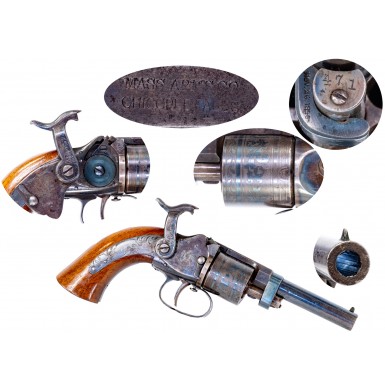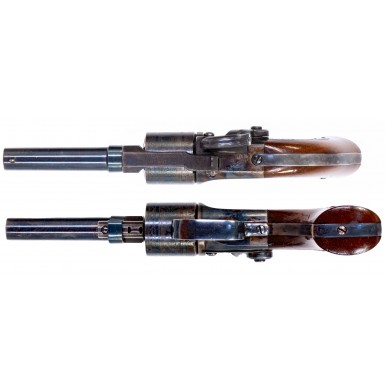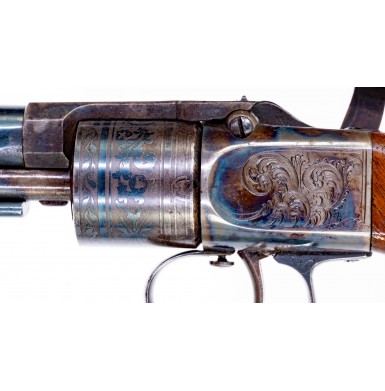Wonderful Mass Arms Maynard Primed "John Brown" Model Manually Rotated Belt Revolver
- Product Code: FHG-LG32-SOLD
- Availability: Out Of Stock
-
$4,500.00
This is a wonderful example of an early Massachusetts Arms Company Maynard Primed Belt Revolver. Although much better known for their later production Adams Patent revolvers and various military carbines like the Greene, Maynard, Smith and Warner, their early production pistols are by far some of the most interesting guns that they produced. The Mass Arms Company was formed in Chicopee Falls, MA in 1849 and was incorporated in 1850. It counted among its incorporators such later luminaries in firearms history as Horace Smith and Daniel Wesson (who would later found Smith & Wesson), Joshua Stevens (later to start the J. Stevens Arms Company), gun designers Edwin Wesson and Benjamin F. Warner (of Warner Carbine fame). James T. Ames of the famous Ames Manufacturing Company was also one of the original incorporators and served as the Chairman of the Massachusetts Arms Company board of directors, as well as providing factory space at Ames for the initial production of Massachusetts Arms firearms.
The first arms produced by Mass Arms were percussion revolvers designed by Edwin Wesson, brother of Daniel Wesson, and Thomas Warner, who was the factory superintendent. The revolvers were produced under patents held by Edwin Wesson and Daniel Leavitt. On April 29, 1837, Leavitt had received US Patent #182 for a revolving pistol design. It is worth noting that this was the second revolving handgun design to receive a US patent, the first being Samuel Colt’s 1836 patent for what would become the Paterson revolver.
The first guns produced in 1850 were the larger “Dragoon” sized revolvers in .40 caliber. Later in 1850, the firm introduced a “Belt” size revolver in .31 caliber. Both revolvers utilized side-mounted, back action locks that operated in a “single action” fashion. They had a hinged top strap that connected the barrel to the rear portion of the frame, which contained the lockwork. The barrel was held in a stationary and locked position by a swinging latch that secured the topstrap to the forward portion of the cylinder arbor pin. The guns had six-shot cylinders with convex beveled fronts. This beveled cylinder face was one of the key features in Leavitt’s patent application, as he claimed the design would reduce the potential for the “chain fire” of adjacent cylinder chambers when the gun was fired. The cylinders also had oval recesses for the percussion cones, which entered the chambers at about a 30-degree angle. The cocking action of the hammer rotated a back plate in the frame of the revolver. This back plate rotated the cylinder by way of a pin, which extended from the plate and engaged an index hole on the rear face of the cylinder. A second, smaller pin would move in and out of the frame, engaging smaller holes on the rear of the cylinder that corresponded to each chamber, allowing for accurate indexing and lock up of the cylinder. The guns were manufactured with round blued barrels, case hardened frames and brass back straps and trigger guards, which were silver-plated. During the brief production run (1850-1851) of Wesson & Leavitt revolvers, Mass Arms produced about 800 of the larger Dragoon revolvers and approximately 1,000 of the Belt revolvers. Production was ended during 1851 due to a successful patent infringement lawsuit that was filed by Samuel Colt. Colt’s suit noted that the Mass Arms revolver violated his patent on a mechanism that revolved the cylinder when the hammer was cocked.
In an attempt to circumvent the Colt patent, and stay in business, the revolver line was redesigned to have the cylinders rotated manually, and to include the Maynard patent automatic tape priming system. It was hoped that the “innovation” of automatic priming would create public interest in the guns, and that the elimination of individual cones (nipples) on the cylinder that required percussion caps for ignition, along with manual cylinder rotation, would help evade any more legal trouble with Colt. The newly designed revolver line debuted in 1851 and included a .31 “Belt” sized revolver and a “Pocket” sized revolver available in .28 or .31 caliber. The guns were quite streamlined, and retained the overall look of the earlier Edwin Wesson design with a hinged barrel that was easily removable from the frame, allowing barrels and lengths to be easily swapped. This same feature would later be an important selling point when the Massachusetts Arms Company added the 1st Model Maynard carbines and rifles to their product line, whose interchangeable barrels allowed a single receiver to be used for a rifle, carbine or shotgun, in various calibers. Despite the “innovative” features, the manually rotated tape primed revolvers did not sell well, and the Massachusetts Arms teetered on the brink of disaster until the expiration of the Colt patent in 1857. At that time the Massachusetts Arms Company redesigned their Maynard primed pocket revolvers to rotate the cylinder automatically when the hammer was cocked. However, in 1857 they also introduced their licensed version of the Adams patent revolver. This was quickly followed up by the introduction of Dr. Maynard’s “1stModel” carbine, which was a successful product as well. Adams patent revolvers were offered in both a large frame .36 caliber “belt size” as well as a small frame .31 caliber “pocket size”. These superior products reduced the popularity of the tape-primed revolvers and production of the tape-primed guns slowed until they were eliminated from the produce line in 1860. A total of about 2,500 tape primed pocket revolvers were produced between 1851 and 1860, while some 4,500 of the pocket-sized Adams revolvers were produced between 1857 and 1861, showing the clear preference by the buying public for the Adams design. Of the tape-primed pocket revolvers, only about 900 or so were of the earlier, manually rotated variant, with the balance being the more conventional automatically rotated version, but even the improved version was not popular. The “Pocket” sized revolvers were typically manufactured with 2 ½” or 3 ½” round barrels, although a number of scarce variations like other barrel lengths and octagonal barrels have been noted. About 1,000 of the larger framed “Belt” revolvers were produced with barrels from 3” to 7”. None of these were ever produced in a double action variant and all had manually rotated cylinders. These belt sized revolvers are known to collectors as the “John Brown Model” because the radical abolitionist purchased 200 of these revolvers in 1857 to help arm his followers when they attacked Harpers Ferry and for his planned slave uprising.
These interesting revolvers were not serial numbered in the typical way but were rather batch or assembly numbered on most of the major components, making it difficult to determine exact production figures. Additionally, like the later 1stModel Maynard Carbines, the ease with which the barrels could be swapped to change lengths meant that “matching numbers” are the exception and not the rule. As it was easy to install different barrel lengths on frames, I have rarely found “John Brown Model” revolvers with barrel lug numbers that matched the frame numbers. It could be assumed that when orders came into the Massachusetts Arms Company, that parts were often exchanged on existing guns in an effort to provide the barrel lengths requested by the order.
The Massachusetts Arms Company was doing quite well as 1860 came to a close, producing a line of successful double action percussion revolvers and Dr. Maynards carbine. With the American Civil War on the horizon and the potential for more military contracts, the company seemed poised on the brink of major success. However, in January of 1861 a fire closed the factory. Dr. Maynard acquired control of the company at this time, but the facility was not repaired, and the company not reorganized until 1863. Despite the success of Maynards “2nd Model” carbine which found favor with the US military and a successful line of sporting rifles introduced as the Civil War wound down, the company went out of business in 1866 only a year after the war ended.
The Massachusetts Arms Company Maynard Primed Belt Revolver offered here is in about VERY FINE+ overall condition. This scarce manually rotated belt sized revolver is a 6-shot, .31 caliber pistol with a fairly uncommon 3 ½” long round barrel and an overall length of about 9 ½”. Most of the revolvers in this line appear to have 4” to 6” barrels, with 5” guns being relatively common for a gun that is not particularly common in any configuration.
The revolver is clearly marked in two lines on the hinged topstrap:
MASS ARMS CO
CHICOPEE FALLS
The face of the cylinder arbor pin is numbered 471, and the face of the barrel catch is marked NOV. 26, 1850. This date references Joshua Stevens’ US Patent #7802 for the barrel locking catch design. The patent would later be disallowed as being a design already invented and in the public domain. The face of the recoil shield is marked with the number 278. As noted, I have rarely encountered matching numbers on these Mass Arms Maynard Primed Belt Revolvers and have to wonder if the numbers are for matching parts of subassemblies. Sometimes the barrel lug and arbor numbers will match, and it has occurred to me that the recoil shield numbers might match internal mechanism numbers, but these guns are too well fit and difficult to disassemble to find out if there are internal numbers that explain the way they are marked. No other visible serial numbers are noted. Like most Mass Arms Maynard Primed Belt Revolvers, the reverse of the frame, lock of the gun and hammer are decorated with simple and elegant scroll engraving. The swiveling tape primer magazine door is decorated with a {Spread-Winged American Eagle} with the arrows and olive branches in its talons, reminiscent of the Eagle stamped on the primer magazine doors of the US Model 1855 series of firearms. The door is additionally marked MAYNARD’S PATENT in a downward arc over the Eagle and SPET. 22, 1845 in an upward arc under the Eagle. The cylinder is decorated with an acid etched floral scene that is very attractive. The sights of these revolvers are rudimentary at best and consist of a small, fixed notch rear sight on the rear of the topstrap, above the hinge pin, and a small, rounded blade front sight near the muzzle.
As noted, the revolver remains in VERY FINE condition. Conservatively, the barrel retains about 65%+ bright blue with thinning and flaked loss mixing with a smooth plum patina that makes the barrel appear to retain more blued finish than it really does. The rotating barrel closure latch retains about 90%+ bright fire blue and is very attractive. The acid etched cylinder retains about 75%+ of its finish, which is all blued but with the raised patterns showing about 70%-80% of their bright blue and the acid etched background retaining a similar amount of its duller matte blue, with fading and dulling towards the rear and some freckles of minor oxidation as well. The frame retains about 85%+ vivid case colors with some fading and dulling. The arbor pin retains about 60%+ of its case coloring, primarily on the interior. The top strap retains about 40% dulled and muted case colors with a smoky blue gray appearance and some muted mottled blue and purple colors. The lock plate has dulled and faded towards a bluish gray with purple tones and shows some traces of mottled coloring with all of the engraving remaining crisp. The hammer retains about 50%+ vivid case coloring, fading and dulling towards a dull grayish-blue color, primarily along the rear edge. The primer magazine door retains some traces of finish with a very attractive plum patina with strong purple tones, some scattered minor freckles of surface oxidation on the exterior and slightly more on the interior and retains crisp markings. The interior of the primer compartment retains much of its bright fire blued finish. The color casehardened grip strap retains traces of mottling with a smoky gray patina. The metal is quite smooth throughout with only some freckled oxidation shot through the finish and some light to moderate pinpricking on the face of the muzzle. The brass backstrap retains about 90%+ of its heavily tarnished silver plating and the triggerguard also retains about 90%+ of its heavily tarnished silver. The grip retains about 85%+ of the original varnish and is in VERY FINE condition. The grip shows a few minor dings and dents from handling and carry and a couple of minor surface chips along the inner left side at the grip frame and on the inner right leading edge at the grip frame. These are very minor and mentioned for exactness and not even readily visible when displayed. The bore is about FINE, it is mostly bright with some scattered oxidation and discoloration and retains very crisp and deep six groove rifling, with some scattered light pitting in the grooves. The revolver remains in EXCELLENT mechanical condition. The manually rotated cylinder works as it should when the release button under the frame is depressed and the spring and locking system retain strong and crisp. The barrel latch system also work as it should, crisp and correctly with it still being necessary to depress the small ball detent to release the catch to rotate it and allow the barrel to tilt up. The hammer functions correctly and crisply and cocking it still operates the tape primer feed mechanism as it should.
Overall, this is a really attractive example of a relatively scarce pre-Civil War tape primed, manually rotated percussion revolver. These guns were produced in limited numbers and were the second generation of some of the first somewhat successful percussion revolvers sold in the US. The revolvers that preceded these were a significant enough threat to Samuel Colt that he went after The Massachusetts Arms Company with all the force of law to end their production. These redesigned revolvers never gained much traction for many reasons but were very well made and have the somewhat dubious historical association with John Brown. This gun is extremely attractive and remains in a wonderful state of preservation. It retains much of its original finish and has such an attractive patina where the finish has worn that it appears to retain even more finish on the barrel than it really does. The revolver remains mechanically excellent with a fine bore and retains markings that are crisp and clear. For any advanced collector of Civil War era percussion revolvers, this would be an outstanding addition to their collection. The revolver would also be a great addition to a collection of early Smith & Wesson revolvers, as the gun was produced by the founders of Smith & Wesson, prior to the establishment of that firm. This is a really fantastic revolver that you will be very proud to add to your collection.
SOLD
Tags: Wonderful, Mass, Arms, Maynard, Primed, John, Brown, Model, Manually, Rotated, Belt, Revolver















